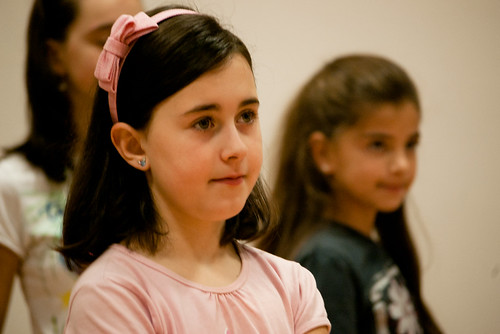
Let me give you a run-down of my teaching career.
After I graduated from high school, I spent four years at a liberal arts college learning a lot about what it means to be a good teacher and almost nothing about how to be a good language teacher.
After graduating from college, I spent three years teaching Spanish to students from sixth through twelfth grades using 90% English grammar explanations and worksheets and homework.
Then I went to graduate school and got a master’s degree in second language acquisition research that blew apart my preconceived notions of how people learn language.
Armed with my M.A, I began teaching Spanish at the high school level. I played around with using more target language and engaging authentic resources, especially music, which caught on with my students like wildfire.
A month after restarting my teaching career, I went to a conference. At the conference, I attended a 3-hour workshop on Teaching Proficiency through Reading and Storytelling (TPRS).
The following Monday, I threw my textbook out the window.
Okay, it wasn’t exactly like that, but it was close. That year, my students continued to take their textbooks home, but we rarely used them. The next year, the textbooks were on a shelf in my room and came off about once a month for an activity. The following year, I left them in the closet upstairs.
This method of engaging students with comprehensible input, TPRS, was powerful. I could tell right away that storytelling was a revolutionary approach that made so much sense in so many ways. Briefly, TPRS is based heavily on Stephen Krashen’s (and others’) research on second language acquisition and theories of the Natural Approach, or the theory that people learn second and more languages in much the same way they learned their first. The TPRS approach incorporates highly repetitive storytelling using the most frequently used words in a language, along with engaging reading materials, to deliver very comprehensible input to students.
In that first 3-hour workshop I attended, a woman taught a story in Swedish for about twenty minutes as a demonstration. For full disclosure, I have to tell you that I have a very high language aptitude, and I have forgotten the story now, but I could have retold the story she told us in Swedish for three or four years following that workshop. So let me start by telling you that to communicate language in a way that causes acquisition, TPRS absolutely works. I love it.
But I also hate it. Well, I don’t hate it, but I part ways with the method in a few areas. Why? Because no method in any classroom can reproduce the process by which children acquire their native language, and every classroom is different, every teacher is different, and every student is different, so any successful method is going to be a combination of strategies that take all factors into account. My job is to take into account all the factors in my situation, evaluate the research I’ve seen, and decide what works for my students, and what doesn’t. Some of TPRS just doesn’t.
You can love TPRS or be wary of it or hate it or just think you couldn’t be good at it, but to help you evaluate it, here’s what I take and leave about the method.
What I love
Comprehensible input
Researchers disagree on all sorts of things, but this is not one of them. The general consensus is that learners acquire language that is comprehensible to them. And TPRS, through storytelling and leveled reading, is all about students comprehending the language. If you see a good TPRS teacher in action, even if you don’t speak much of the language involved, you’ll be stunned at how much you can comprehend.
Communicative
A TPRS teacher recently disparaged the “communicative” classroom, but I cannot understand why. Communicative language teaching is about communicating meaning, and TPRS communicates meaning. It’s not about students learning how to talk about the language; it’s about students comprehending and using language in real-life situations – or in crazy situations in stories, but still, language they can transfer to any situation they need to.
Scaffolding
With TPRS you can take content and scaffold it in such a way that your highest to lowest learners understand. I abandon most storytelling by the time my students reach their fourth year, but I still use it to scaffold authentic resources like news stories and novels and it’s a great way to preview those materials.
Storytelling
If you have children, think about how they’ve acquired language in your family. Children listen to stories constantly. Life is a story, and telling stories is a life skill. Storytelling works, period.
Questioning
TPRS teachers don’t tell stories so much as they ask stories. In my novice classes, I don’t have to teach question words, ever. And students rarely confuse them. We simply use them so much they’re part of us.
After all, questioning is something that happens nonstop. From the time a baby is born (and I have a lot of experience in this the last few years!), everyone is asking him questions: are you hungry? what does a cow say? where is your binky? oh, did you like that? And all this questioning and storytelling means you can guarantee…
High levels of TL
I do not know how teachers can stay in the TL with novices the ACTFL recommended 90% of the time (or even close) without storytelling. When I started storytelling I found it incredibly easy to stay in the TL with high comprehensibility. When you’re not stopping to explain a grammar point every few minutes, but rather telling stories and asking a million questions, you can stay in the TL a whole lot.
Student engagement
The point of stories in TPRS is to get content to students in an engaging way. Aside from something you might be targeting in particular (though that in itself is not a major tenet of TPRS-more later), the content of the stories doesn’t matter. The best TPRS teachers I have seen incorporate their students into the stories. I started doing this from the start of my storytelling integration and watched the engagement soar. My students are always hotter than Justin Bieber, play tennis better than Nadal, play the guitar better than Santana, and so on. They’re the stars, they’re cool, they’re heroes, and they love it. More importantly, they pay attention to it.
Lower frustration
Straightforward enough, frustration blocks acquisition and when students understand what you’re doing and it’s engaging, they don’t get so frustrated.
That’s what I love about TPRS. Check back in a few days for the (very extensive) flip side of this coin.
13 Comments
Comments are closed.




Couldn’t agree with your more! I feel like I could have written this…it is so similar to my career (the best day was when I “threw away” the textbook!) and I can’t imagine teaching any other way!
I appreciate the post re: TPRS. Here are my concerns:
I attempted TPRS about five years ago, and didn’t proceed with it. I was even a part of the TPRS Yahoo! group for a time. I quit. Honestly, I found the group, and the approach, cultish. In other words, very lock-step, never deviating from the structure, etc. Now, I have come to realize since that time that, like many things, there are many ways to approach TPRS. There also seems to be a regimen, e.g. training the students to respond in certain ways as the stories are being told. Last, the stories – well – I find them rather weird. Perhaps Blaine Ray developed them for kid-appeal, but, as a teacher, they didn’t line up with my pedagogical beliefs.
Having said all of the above, virtually all of the points you outline in your post do appeal to me as a language teacher, and do align with my pedagogy.
Thoughts?
Believe me, you are not alone in your wariness. You used the word “cultish” – in other recent conversations a teacher described the movement as “hippie” and a top author/speaker in language teaching used the phrase “unthinking mentality.” Personally, I’ve had the privilege of interacting with such open-minded, respectful TPRS teachers that I hadn’t felt this way until just recently, when I was basically told that it’s the only way, and if you’re not 100% on the Blaine Ray tenets you’re going to fail. The hard-line TPRS response to your problems is “You’re not doing it right. If you were, you’d be wildly successful like I am.”
Please, check back on Tuesday for the flip side of this post, “What I hate about TPRS.” I hope it addresses many of your concerns. At the end of it, there are links for how you can contact some people who could help you even more than I could with integrating the best of TPRS in your classroom. My opinion is that the one most powerful aspect of TPRS is incorporating storytelling to pattern content, and you can find out more about how I do that through my storytelling tag. I hope you find something there you can use – although, unlike some TPRS teachers I have spoken with recently, I am not so blind as to think that if you could just be me all your problems will go away! 😉
Side note, the stories from TPRS Publishing are a whole lot more engaging than Blaine Ray’s. My level 3 students never stopped using Patricia Va a California references as a joke to mock their Spanish 1 experience.
[…] (after a too-long FB search to find the post), I am waiting to hear the “con” side of this story. I love this post! It’s a typical TPRS story, if that exists. I admit to being jealous of […]
[…] post I started about what I love and hate about TPRS grew to be so long I decided to split it in half. My […]
[…] In all fairness, here is Sara-Elizabeth’s companion post on What I Love About TPRS. Thanks for the comment and for wanting to set things straight, […]
[…] I first started investigating TPRS as a teaching method, a lot of things clicked with me (and some didn’t) but one of the tips that made the most sense was that it didn’t make […]
[…] my post about where I depart from the classic (think Slavic, Ray) TPRS practices, please read what I love about TPRS (and then you can read Carol Gaab’s rebuttal) whose tenets revolutionized my teaching and […]
[…] square fully with my beliefs re: teaching, learning, language acquisition, and assessment. I like some of its tenets, but, some of them leave big questions in my mind. That’s […]
How do you find authentic texts to incorporate in your TPRS in the target language?
Great question! Right now my early language class (ages 7-12) and I are exploring the animals of Ecuador. We’re using Mira Canion’s Capibara con botas, but we’re using it the whole semester. Each week (I see my kiddos once a week) we explore a chapter or two and often a new animal. So I search in Spanish, for example, “información puma niños” or “infografía mono Amazonas” and see what comes up in Google. Then I take the information and I don’t alter it, but I do cull it – that is, I pull from it the information I want and we use that in class. You can see examples here. I hope this helps.
These materials are generally written by TPRS teachers themselves; so far, the large publishing companies have been reluctant to publish materials that aren’t based upon a fixed grammar syllabus.
I love getting spontaneous responses to the questions I ask in Spanish, and also I have gotten to know my students way better than I did before.